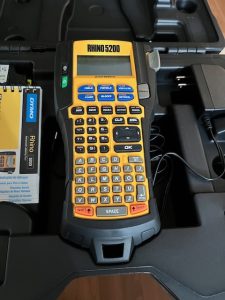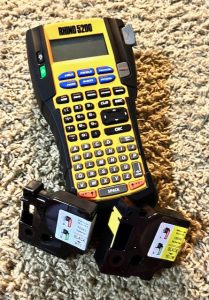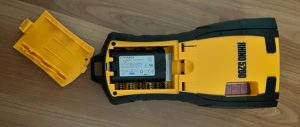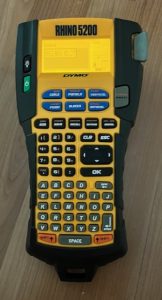Dymo Rhino 5200 Review

Dymo Rhino 5200
I love label makers. And any time I find a label maker at a good deal I will include it to the harem. As luck would have it I found a great deal on a used Dymo Rhino 5200.
Brand new they go for approximately $150 for just the printer and around $200 with the hard case kit.
The term “used” while accurate doesn’t do this one justice. This one looks like it is fresh out of the plastic wrap. Even better I got it for an exceptional price.
I already own several Dymo label printers and most notably this label makers big brother, the Dymo Rhino 6000+.
So let’s shake it down and see what I think about it.
Dymo Rhino 5200 First Impressions
As I mentioned this label maker is just like brand new. I couldn’t find a scratch on it. I put a label cassette in to test it and found that there were no issues with the thermal print head.
After checking the serial number it reveals that my particular printer was manufactured in Nov 2019. Thanks to the Support people at Dymo for helping me with that! Originally the Dymo Rhino 5200 was released in 2009. That is impressive for a tech gadget in this day and age.
Speaking of that print head when I went to look at the print resolution I noticed it wasn’t mentioned in the manual. Neither was it in the product literature. I had to dig kinda deep to see that it is 180 dots per inch (DPI).

Resolution
I think i can see why it isn’t prominently mentioned. 180 dpi is kind of the lower end of resolution with modern label printers. That being said, 180 dpi is more than adequate for a label maker. Additionally, there are a lot of people who I call “pixel peepers” who discuss specs to death without factoring in real life results. Conversely, those people would look at “180” and rapidly move on. I am not one of those people. My criteria is “can you read it legibly”. The answer to that it “yes”.
Practicality
Another important thing to note is that the 5200 is a stand alone label printer. It cannot be tethered to a computer. It does however have an ample library of symbols for home and industrial usage.

Symbols
If you absolutely require the need to add unique symbols, this label printer may not be for you.
Having said that, there are really only a few hand held labelers that can be computer controlled.
The whole concept of using a hand held printer though is mobility. Symbols included are:
- Electrical
- Voice/Data
- Warning
- Punctuation
- Brackets
- Arrows
- Numbers
- Currency
Consumables

Labels
The printer can handle up to 3/4″ labels, which is a respectable size. Cassettes comes in various types such as Polyester, Vinyl, Flexible Nylon and Heat Shrink Tubes.
They are not terribly cheap and in my town I can barely find them in any stores. They take D1 labels and you might occasionally see them at Staples or Walmart. While they might have black lettering on white there certainly aren’t many color selections and no heat shrink or other specialty labels.
I just get them online. I recommend buying from Image Supply or Label City.
There are 3rd party consumables that are much cheaper however Dymo doesn’t recommend them and neither do I. I guess if I had a $30 label maker I wouldn’t care but the Rhino 5200 is a TOOL.
I wouldn’t take a chance on messing up the print head on 3rd party labels.
Power
The label maker can be powered by a rechargeable 7.4 V, 1400 mAh battery. Alternatively, you can use 6 AA alkaline batteries. AA rechargeable batteries are not recommended as they typically are lower voltage than alkalines.
The kit includes a charging brick and the battery must be charged in the printer.

Battery Compartment
Usability

keyboard
The Dymo Rhino 5200 does not have a QWERTY keyboard. The keyboard is arranged in alphabetical order.
The screen is just grayscale and not color like my Dymo XTL 300. But the LCD is very usable. The backlight is adequate and stays lit for 15 seconds.
The backlight button is accessible easily.
Additionally, there is no automatic label cutter and the label cutting lever sticks out a bit. I could see that being a problem in the wrong hands.
If the label doesn’t extend past the chute you have to hold it while trying to push down on the cutter. It is a little bit awkward.
There are tons of options and settings and it is strongly recommended to actually read the manual to familiarize yourself with the label maker.
Lots of people probably do simple text labeling, but this is an industrial labeler for heat shrink tubing and labelling things like network switches and cable wraps.
Hard Case
I’m a sucker for hard cases and proper storage of my tools. The Rhino 5200 hard case is awesome.

Hard Case
My only beef with the case is that I wished it held more label and tape cassettes. You can cram a few in there but it isn’t very elegant.
Is Anything Missing?
Depends on what you need to do. I have an Epson LW-PX900 that has a greater mix of label types available. I especially love the 1 1/2″ Magnetic Tapes. They also have wire wraps, florescent labels, and die cut labels. If you have a broader range of labeling requirements then look at the Epson. BUT……the Epson LW-PX900 clocks in at around $289 for just the printer and nearly $350 for the kit with a hard case. A substantial jump in price. Consumables for the Epson cost roughly the same for standard label cartridges.
Cross Compatibility
Some Dymo printers also use D1 cartridges. My Dymo LabelManager 280 uses them (up to 1/2″) as well. Having a basic label printer and an industrial printer that uses the same consumables is a giant plus. Dymo uses the D1’s in a LOT of printers. Here is a decent compatibility chart.
There is a lot to be said for that. If you have a label maker fetish like I do then you’d know that I have plastic bins full of consumables for several brands of label printers. How cool would some cross compatibility be?
Conclusions
The Dymo Rhino 5200 is an awesome label printer for the working man or woman. If all you want to do is text label a few things, this is overkill.
But this guy builds electronic gadgets and has a heck of a home network. Labelling my cables with shrink wrap is a must have capability. Labelling my network ports is also a requirement for staying organized. Putting the IP address on all my gadgets is helpful as well.
If you do anything besides simple labels then you need a label maker like this.
Finally, don’t be a pixel counter and be put off by the 180 dpi resolution. Trust me, it is good enough for what you need to do.
John’s Tech Blog recommends the Dymo Rhino 5200 label printer.

I have anymore Rhino 5200 that is probably 5-7 Years old and it worked well when new. I purchased the kit with case and rechargeable battery. It sits normally but when I went to use it last year I noticed the print was lighter than normal and it was missing part of the print. Recharging to full power helped as well as cleaning the print head. Now a year later the printing is blank and you can see where it it trying to print as you can see it when at the right viewing angle. Now the lcd screen is blank as well. The printer is in excellent condition and probably 5 hours total use and Dymo only has a one year warranty. I just purchased an Epson LW-PX700 printer that has a no questions asked lifetime warranty last night. May you have better luck than I with your Dymo.
Sorry to hear about your Dymo. I understand fully your comments on the Epson. I have the LW-PX900PCD kit and it is far and above my favorite printer.